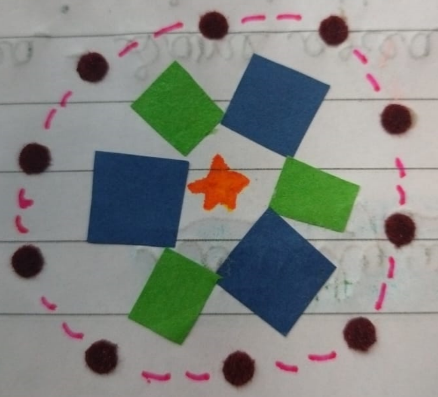Activity W2.7 Rangoli Making
In this activity students will be able to make different shapes using the chart paper and
then arrange them into beautiful rangoli/ kolam
Ask the children (in group) to make different shapes using coloured chart papers.
They may be asked to make different rangoli/kolam.
Activity W2.7: Rangoli Making – Exploring Geometry Through Art
Objective:
To help students explore geometry, symmetry, patterns, and aesthetic design through a creative and collaborative activity—making rangoli (kolam) using cut-out shapes.
This activity strengthens spatial understanding, shape recognition, and artistic expression.
Materials Needed:
-
Colored chart paper
-
Scissors
-
Glue or double-sided tape
-
Pencils, rulers, and compasses (for precision)
-
A3 or A2 sized base sheet for pasting designs
Concepts Involved:
-
2D shapes (triangles, squares, circles, rhombuses, hexagons, etc.)
-
Symmetry and reflection
-
Pattern and repetition
-
Tiling and tessellation
Procedure:
-
Group the students into small teams of 3–5 members.
-
Ask them to cut out basic shapes like:
-
Squares
-
Triangles
-
Circles
-
Semicircles
-
Petals
-
Diamonds/rhombuses
-
Stars
-
-
Each group should design their own rangoli/kolam on chart paper or a flat surface by:
-
Arranging shapes in symmetric or circular patterns
-
Exploring repetition and rotation
-
Using contrasting colors for beauty
-
-
Once satisfied, students can paste the shapes onto a base sheet.
Examples of Rangoli Designs:
| Design Name | Description | Shapes Used |
|---|---|---|
| Lotus Mandala | Petals arranged in a circular pattern | Ovals, circles, triangles |
| Geometric Star Rangoli | Star at the center with repeated diamond shapes | Stars, diamonds, triangles |
| Symmetry Butterfly | Mirror-symmetric design of a butterfly | Semicircles, triangles |
| Flower Garden Kolam | Repeated flower patterns in a grid | Circles, petals, squares |
Discussion Questions:
-
What shapes did you use in your design?
➤ Answers will vary: squares, circles, triangles, etc. -
Was your rangoli symmetrical?
➤ Many designs will be symmetrical; ask how they achieved that. -
Did you face challenges while arranging the shapes?
➤ Some might mention fitting or matching angles and sizes. -
What makes one design more visually appealing than another?
➤ Use of color contrast, repetition, symmetry, and balance.
Conclusion:
This activity combines mathematics with art, reinforcing concepts of geometry, area, symmetry, and design in a fun and engaging way. It fosters teamwork, creativity, and appreciation of traditional cultural art forms like kolam or rangoli.






No comments:
Post a Comment